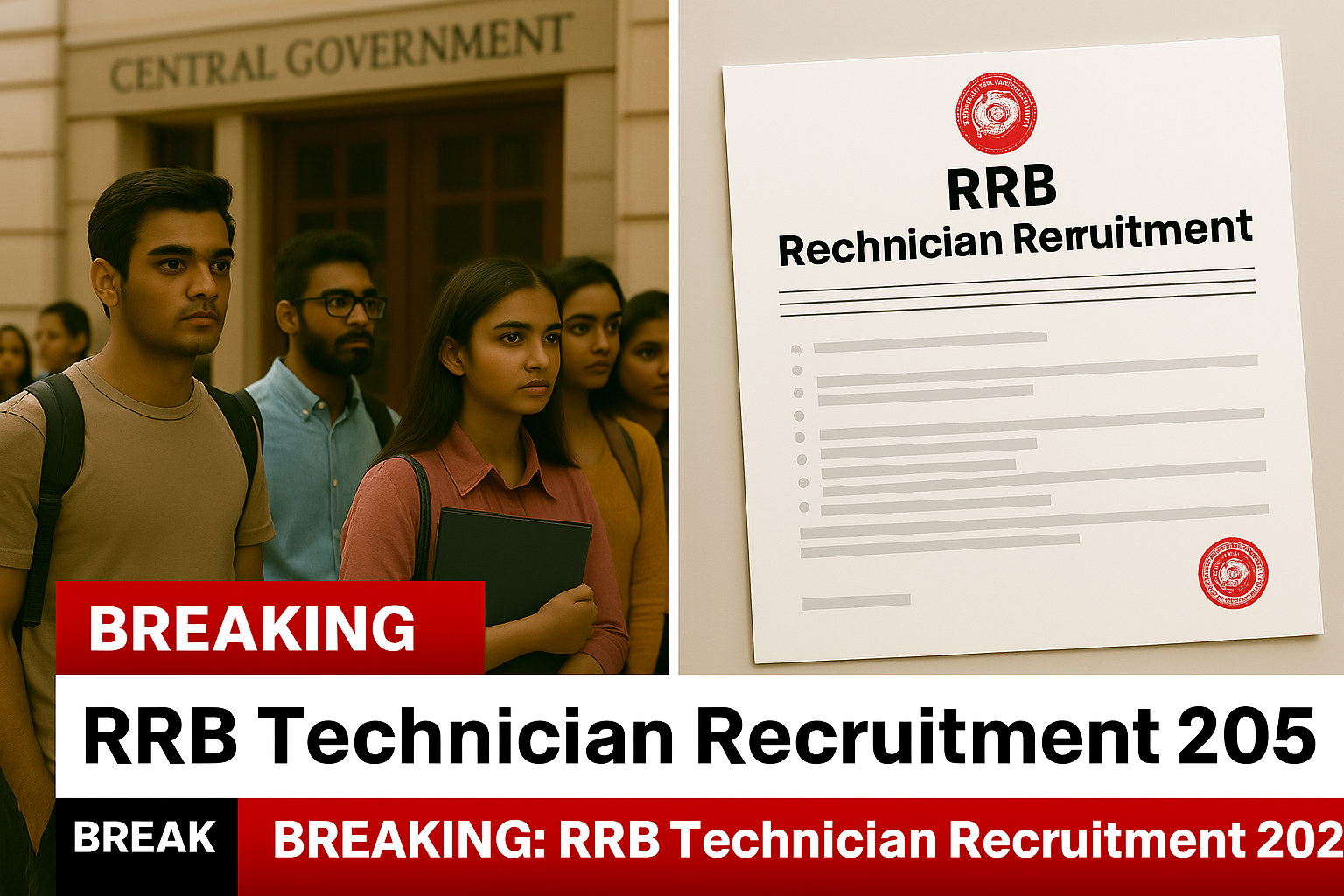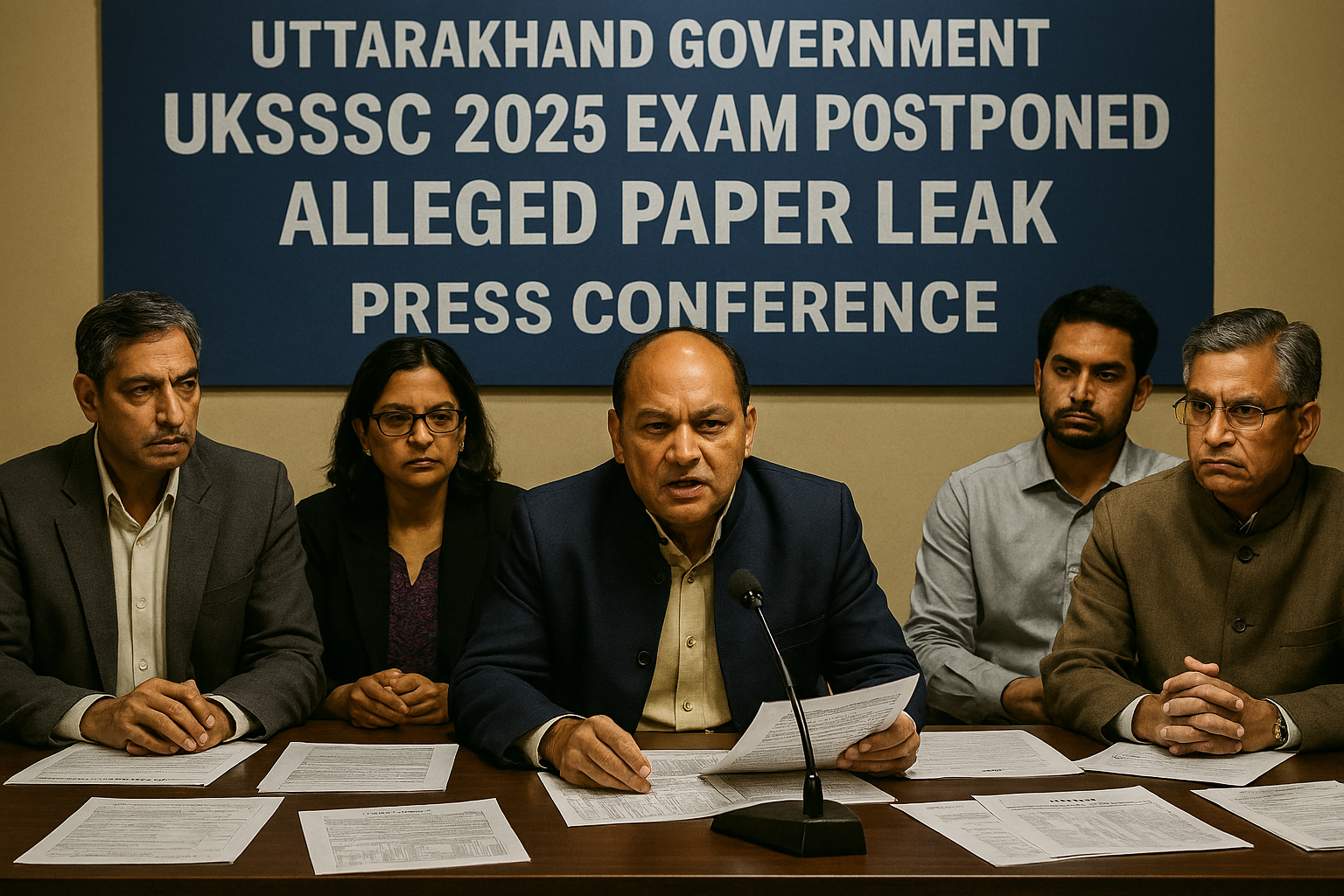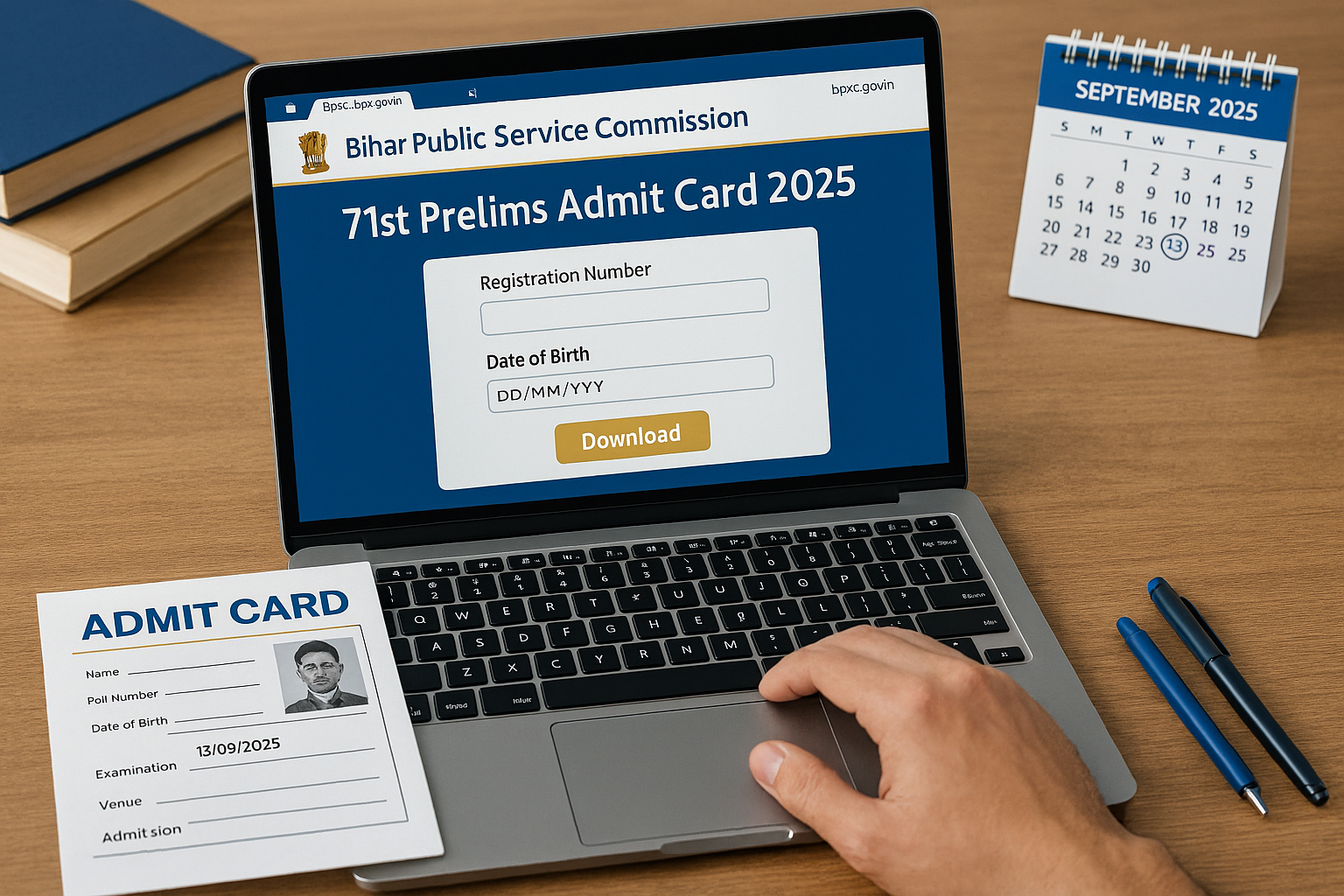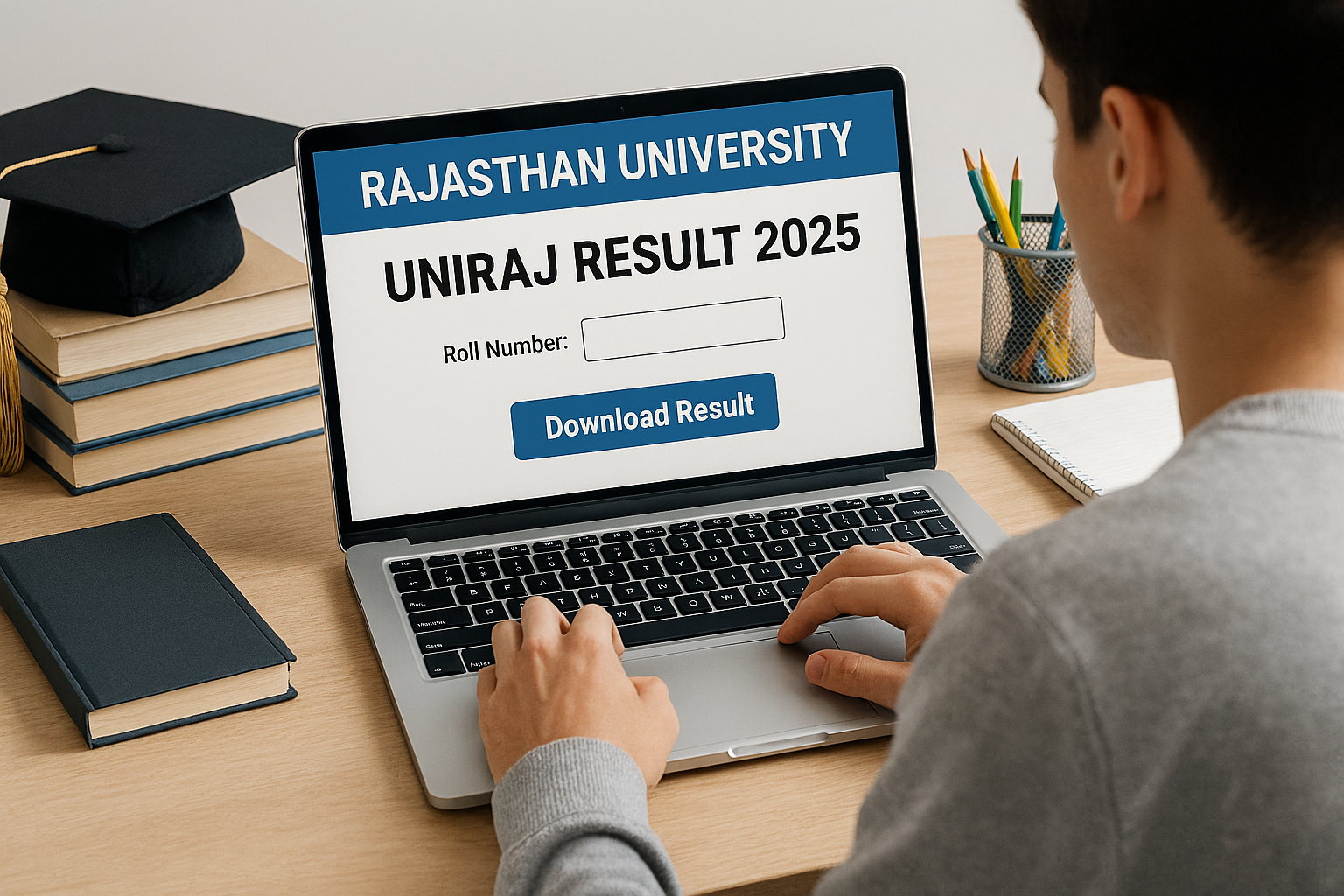
RRB Technician Recruitment 2025: A Golden Technical Career Opportunity

Table of Contents
Introduction: Railway Recruitment Board Announces Major Technical Hiring Drive
The Railway Recruitment Board has released Centralized Employment Notification (CEN) 02/2025 on June 27, 2025, announcing 6,180 technical positions across Indian Railways. This recruitment initiative provides opportunities for qualified candidates to secure government employment in various technical trades and specializations.
The positions are distributed across two grades: 180 openings for Technician Grade-I (Signal) and 6,000 openings for Technician Grade-III covering multiple technical trades. Applications will be accepted online from June 28 to July 28, 2025, through the official portal.
This article provides verified information about eligibility criteria, application procedures, selection stages, compensation details, and preparation guidelines based on official RRB notifications. All information has been cross-referenced with government sources to ensure accuracy.
Official Notification Details and Position Breakdown
Total Vacancies and Grade Classification
The recruitment encompasses 6,180 sanctioned positions divided into two distinct technical grades:
Technician Grade-I (Signal): 180 Posts
- Specialized roles in signaling and telecommunication systems
- Requires advanced knowledge in electronics and computer systems
- Focuses on safety protocols governing train movements
- Involves maintenance of signal equipment across railway networks
Technician Grade-III: 6,000 Posts
- Multiple trade specializations available
- Includes mechanical, electrical, and civil trades
- Covers operational maintenance requirements
- Spans diverse technical disciplines
Trade Categories for Grade-III Positions
The Grade-III recruitment covers the following technical trades:
Mechanical Trades:
- Fitter
- Turner
- Machinist
- Welder
- Carpenter
- Blacksmith
- Sheet Metal Worker
- Motor Vehicle Driver
Electrical Trades:
- Electrician
- Electronics Mechanic
- Wireman
- Instrument Mechanic
Civil Trades:
- Mason
- Painter
- Plumber
Specialized Trades:
- Foundryman
- Moulder
- Pattern Maker
- Forger & Heat Treater
- Refrigeration & Air Conditioning Mechanic
Geographic Distribution Across Railway Zones
Positions are available across major railway zones including:
- Northern Railway
- Southern Railway
- Eastern Railway
- Western Railway
- Central Railway
- Metro Railway Kolkata
- Konkan Railway Corporation
- Additional specialized zones
This distribution allows candidates to apply for positions closer to their home regions, addressing geographic preferences.
Eligibility Criteria: Educational Qualifications and Age Requirements
Educational Requirements for Technician Grade-I (Signal)
Candidates must possess one of the following qualifications:
Option 1: Science Degree
- Bachelor of Science in Physics
- Bachelor of Science in Electronics
- Bachelor of Science in Computer Science
- Bachelor of Science in Information Technology
- Bachelor of Science in Instrumentation
- Related disciplines from recognized universities
Option 2: Engineering Qualification
- Diploma in Electronics Engineering
- Diploma in Computer Science Engineering
- Diploma in Information Technology
- Diploma in Instrumentation Engineering
- Diploma in Telecommunication Engineering
- Bachelor’s degree in above disciplines
- Institution must have AICTE approval
Educational Requirements for Technician Grade-III
Candidates must meet the following criteria:
Basic Education:
- Matriculation (10th standard) from recognized board
- SSLC or equivalent qualification
Technical Certification:
- ITI certificate from NCVT in relevant trade
- ITI certificate from SCVT in relevant trade
- Recognized apprenticeship completion in applicable trade
The apprenticeship option provides flexibility for candidates who gained skills through workplace training programs.
Age Limit Specifications
Age calculation date: July 1, 2025
Technician Grade-I (Signal):
- Minimum age: 18 years
- Maximum age: 33 years
Technician Grade-III:
- Minimum age: 18 years
- Maximum age: 30 years
Age Relaxation for Reserved Categories
The government provides age concessions as follows:
| Category | Relaxation Period |
|---|---|
| Scheduled Caste (SC) | 5 years |
| Scheduled Tribe (ST) | 5 years |
| Other Backward Classes (OBC) | 3 years |
| Persons with Disabilities (PWD) | 10 years |
| SC/ST PWD | 15 years |
| Ex-Servicemen | Service period + 3 years |
| Widows/Divorced Women | 9 years (up to age 35) |
Nationality Requirements
Eligible candidates include:
- Citizens of India
- Citizens of Nepal
- Citizens of Bhutan
- Tibetan refugees (arrived before January 1, 1962)
- Persons of Indian origin from Pakistan, Myanmar, Sri Lanka, or East African countries with settlement intentions
Persons of Indian origin require eligibility certificates from the Government of India.
Application Process: Step-by-Step Registration Guide
Online Registration Procedure
Step 1: Portal Access
- Visit official website: rrbapply.gov.in
- Locate CEN 02/2025 notification link
- Click “New Registration” to begin
Step 2: Contact Information
- Provide active email address
- Enter valid mobile number
- Receive unique registration number
- Store login credentials securely
Step 3: Personal Details Entry
Enter the following mandatory information:
- Full name (matching matriculation certificate)
- Father’s name and mother’s name
- Date of birth (must match documents)
- Gender and category declaration
- Nationality and domicile state
- Special category status (if applicable)
Step 4: Educational Information
Provide complete details about:
- Matriculation: Board name, passing year, roll number, marks percentage
- ITI/Diploma/Degree: Institution name, trade/discipline, passing year, marks obtained
- Upload scanned certificates meeting technical specifications
Step 5: Post Preference Selection
Carefully choose:
- Preferred grade (Grade-I or Grade-III)
- Specific trade for Grade-III applicants
- Railway zone preferences in priority order
- Examination center city preference
Step 6: Document Upload Requirements
Prepare scanned documents with these specifications:
| Document Type | Format | Size | Specifications |
|---|---|---|---|
| Photograph | JPG | 20-50 KB | 3.5 cm × 3.5 cm, white background |
| Signature | JPG | 10-20 KB | Clear and legible |
| Certificates | Max 1 MB each | Educational documents | |
| Category Certificate | Max 1 MB | SC/ST/OBC/EWS proof | |
| PWD/Ex-Servicemen | Max 1 MB | If applicable |
Step 7: Fee Payment Process
Payment modes available:
- Credit Card
- Debit Card
- Net Banking
- UPI
Save payment receipt after transaction completion. Fee payment deadline extends to July 30, 2025.
Step 8: Final Submission
- Review all information using preview function
- Check for errors or omissions
- Click “Final Submit” button
- Download application confirmation page
- Print multiple copies for future reference
Application Fee Structure
Concessional Fee Category: ₹250
Applicable to:
- Scheduled Caste candidates
- Scheduled Tribe candidates
- Ex-Servicemen
- Persons with Disabilities
- Women candidates
- Transgender candidates
- Economically Weaker Section candidates
- Minority community candidates
Full refund provided upon CBT appearance.
Standard Fee Category: ₹500
Applicable to:
- General category male candidates
- OBC male candidates
₹400 refunded after CBT appearance (net cost: ₹100).
Refunds are processed directly to bank accounts within 45-60 days of test completion.
Application Correction Window
Correction period: August 1 to August 10, 2025
Modifiable Details:
- Examination center preference
- Communication address
- Email and mobile number
- Category declaration (with documents)
- Photograph or signature upload
Non-Modifiable Details:
- Name
- Date of birth
- Father’s name
- Educational qualifications
- Selected post/trade
Ensure critical information accuracy during initial submission.
Scribe Details Submission for PWD Candidates
Submission period: August 11 to August 15, 2025
Required Information:
- Scribe’s full name
- Scribe’s qualification details
- Relationship to candidate (if any)
- Scribe’s identity proof upload
- Recent photograph of scribe
- Undertaking regarding scribe eligibility
Scribes must have educational qualifications one level below the applied post.
Selection Procedure: Three-Stage Assessment Process
Stage 1: Computer-Based Test (CBT)
Examination Format:
- Objective multiple-choice questions
- Computer-administered test
- Negative marking: ⅓ mark deduction per wrong answer
- Available languages: Hindi, English, regional languages
Separate Tests by Grade:
The RRB conducts distinct examinations for each grade level.
Grade-I (Signal) Focus Areas:
- Electronics and telecommunications theory
- Signal systems and digital electronics
- Computer fundamentals and communication systems
- Mathematical aptitude for engineering applications
Grade-III Focus Areas:
- Trade-specific technical questions from ITI curriculum
- General science fundamentals
- Basic mathematics and logical reasoning
- General awareness including railway knowledge
Test Duration and Structure:
- Typical duration: 90 minutes
- Question count: 75-100 questions
- Exact details announced closer to test dates
Normalization Process:
Since CBT sessions occur over multiple days with different question sets, the RRB applies statistical normalization. This adjustment ensures fairness by accounting for difficulty variations across sessions.
Merit List Preparation:
Merit lists are prepared separately for:
- Each category (General, SC, ST, OBC, EWS)
- Each railway zone
- Candidates scoring above qualifying marks
- Those ranking within required cutoffs
Shortlisted candidates proceed to Document Verification stage.
Stage 2: Document Verification (DV)
Shortlisted candidates receive calls for verification at designated centers within their applied zone.
Documents Required (Originals + 2 Self-Attested Photocopies):
- Matriculation certificate (age and education proof)
- ITI/Diploma/Degree certificates and mark sheets
- Category certificate from competent authority
- PWD certificate from authorized medical board
- Ex-Servicemen discharge certificate
- Domicile certificate
- Character certificate
- Recent passport-size photographs
Verification Process:
Railway officials examine each document against application data. Even minor discrepancies like name spelling variations may lead to disqualification. Candidates must ensure complete document accuracy.
Provisional Eligibility Status:
Successful verification grants provisional eligibility, subject to medical examination clearance and police verification.
Stage 3: Medical Examination
Medical Standards Assessment:
Vision Requirements:
- Distant vision standards
- Near vision standards
- Color perception (critical for signal posts)
Hearing Standards:
- Adequate hearing capability
- Without hearing aids requirement
Physical Fitness:
- Ability to perform job-related physical tasks
- No disqualifying health conditions
- Absence of contagious diseases
Examination Components:
- General physical examination
- Vision and hearing tests
- Chest X-ray
- Blood tests (hemoglobin, blood group)
- Urine analysis
- Specialist consultations if needed
Medical Categories:
Railway medical classification ranges:
- A1: Fully fit for all categories
- A2/A3: Required for technician positions
- D: Temporarily unfit
Appeals Process:
Candidates declared medically unfit may appeal to higher medical board. The appellate authority’s decision is final.
Final Merit List and Appointment
After completing all three stages, the RRB prepares final merit lists considering:
- CBT normalized scores
- Category-wise reservation compliance
- Zone-wise vacancy allocation
- Medical fitness status
Selected candidates receive appointment letters specifying:
- Posting location details
- Reporting date and time
- Initial training duration
- Training location
- Probation period (typically two years)
- Confirmation procedures
Salary Structure and Benefits Package
Basic Pay Under 7th Pay Commission
Technician Grade-I (Signal):
- Pay Level: Level 5
- Entry Basic Pay: ₹29,200 per month
- Annual Increment: 3% of basic pay
Technician Grade-III:
- Pay Level: Level 2
- Entry Basic Pay: ₹19,900 per month
- Annual Increment: 3% of basic pay
Allowances and Additional Benefits
Dearness Allowance (DA):
- Current rate: Approximately 50% of basic pay
- Revised biannually based on consumer price index
- Compensates for inflation impact
House Rent Allowance (HRA):
- X-classification cities (metros): 24% of basic pay
- Y-classification cities: 16% of basic pay
- Z-classification cities: 8% of basic pay
- Alternative: Railway quarters at nominal rent
Transport Allowance:
- Fixed monthly amount: ₹1,600-₹3,600
- Varies by city classification
Other Regular Allowances:
- Running Allowance for mobile duties
- Night Duty Allowance
- Washing Allowance for uniform maintenance
- Special Compensatory Allowances
Retirement and Long-Term Benefits
Provident Fund:
- Employee contribution: 12% of basic pay
- Employer contribution: 12% of basic pay
- Interest rate: Currently 8.15% annually
Gratuity:
- Lump sum payment upon retirement
- Eligibility: After 5 years service
- Calculation: (Basic Pay + DA) × 15/26 × Years of Service
Pension Benefits:
- Monthly pension post-retirement
- New Pension Scheme (NPS) for recent joiners
- Coverage for qualified service years
Medical Benefits:
- Lifetime healthcare coverage
- Coverage for self and dependents
- Access to railway hospitals
- Empaneled private facilities
Total Compensation Analysis
Annual Package for Grade-I Technician:
- Basic Pay: ₹3.50 lakh
- Dearness Allowance (50%): ₹1.75 lakh
- House Rent Allowance (16%): ₹0.56 lakh
- Other allowances: ₹0.50 lakh
- Employer’s PF contribution: ₹0.42 lakh
- Total CTC: Approximately ₹6.73 lakh per annum
Annual Package for Grade-III Technician:
- Basic Pay: ₹2.39 lakh
- Dearness Allowance (50%): ₹1.19 lakh
- House Rent Allowance (16%): ₹0.38 lakh
- Other allowances: ₹0.40 lakh
- Employer’s PF contribution: ₹0.29 lakh
- Total CTC: Approximately ₹4.65 lakh per annum
These figures exclude non-monetary benefits like subsidized accommodation and free/concessional rail travel.
Career Growth Opportunities in Railway Service
Promotion Pathways from Grade-III
Career Progression Timeline:
- After 5-7 years: Technician Grade-II (Pay Level 3, ₹21,700)
- After 12-15 years total: Technician Grade-I (Pay Level 5, ₹29,200)
- After 20-22 years total: Senior Technician (Pay Level 6, ₹35,400)
- After 28-30 years: Supervisory cadre positions
Promotion Pathways from Grade-I
Career Progression Timeline:
- After 6-8 years: Senior Technician (Pay Level 6)
- After 14-16 years total: Junior Engineer (Pay Level 7, ₹44,900)
- After 24-26 years total: Assistant Engineer/equivalent (Pay Level 8)
Training and Skill Development
Initial Training Program:
- Duration: 3-6 months intensive training
- Railway rules and regulations
- Safety protocols and procedures
- Trade-specific technical skills
- First aid and emergency response
Periodic Refresher Training:
- Mandatory courses every 3-5 years
- Updates on technological advancements
- Skill enhancement programs
Specialized Certifications Available:
- Advanced signaling systems
- New railway technologies
- Supervisory skills development
- Computer applications
Educational Support:
- Study leave provisions
- Financial assistance for correspondence courses
- Promotion preference for additional qualifications
Lateral Movement Options
Railway employees can explore:
- Transfers across different zones
- Deputation to railway production units
- Secondment to railway public sector undertakings
- Selection to specialized units
Preparation Strategy for Computer-Based Test
Understanding Syllabus Components
Grade-I (Signal) Weightage:
- Electronics Engineering: 35-40%
- Signals and Telecommunications: 25-30%
- General Intelligence: 15-20%
- Mathematics: 15-20%
- General Awareness: 10%
Grade-III Weightage:
- Trade-specific knowledge: 50-55%
- General Science: 20-25%
- Mathematics: 15-20%
- Reasoning: 10-15%
- General Awareness: 5-10%
Recommended Study Materials
For Grade-I Candidates:
- Comprehensive guides from established publishers
- Electronics engineering textbooks
- Signal systems reference materials
For Grade-III Candidates:
- NCVT-approved ITI textbooks
- Trade-specific curriculum materials
- Previous year question compilations
General Subjects:
- Standard general knowledge books
- Reasoning guides from recognized authors
- Current affairs magazines
Digital Resources:
- Official RRB website for previous patterns
- Reputable educational platforms
- Established coaching institute materials
Three-Phase Study Schedule
Phase 1: Foundation Building (Weeks 1-4)
Time allocation:
- Trade/technical subjects: 60%
- Mathematics/reasoning: 25%
- General awareness: 15%
Focus activities:
- Complete syllabus coverage
- Understand fundamental concepts
- Create summary notes
- Identify weak areas
Phase 2: Practice and Application (Weeks 5-8)
Time allocation:
- Revision: 40%
- Problem-solving: 50%
- Mock tests: 10%
Focus activities:
- Solve previous year questions
- Practice sectional tests
- Improve calculation speed
- Eliminate common errors
Phase 3: Test Series and Refinement (Weeks 9-12)
Time allocation:
- Mock tests: 70%
- Weak area targeting: 20%
- Current affairs: 10%
Focus activities:
- Full-length timed mock tests
- Performance analysis after each test
- Revise flagged concepts
- Build examination temperament
Mock Test Strategy
Selecting Quality Mock Tests:
- Follow actual CBT pattern
- Match difficulty level
- Provide detailed solutions
- Offer performance analytics
Test-Taking Approach:
- Simulate actual exam conditions
- Maintain timing discipline
- Track time per question (60-90 seconds)
- Mark questions for review
Post-Test Analysis:
- Calculate section-wise accuracy
- Identify topic patterns in errors
- Determine error sources
- Adjust study plan accordingly
Examination Day Guidelines
Before the Test:
- Reach center 30 minutes early
- Carry admit card and photo ID
- Bring black pen
- Use restroom before entry
During the Test:
- Read instructions carefully
- Start with strongest sections
- Skip difficult questions initially
- Avoid excessive guessing
- Reserve 5 minutes for review
Managing Test Anxiety:
- Practice deep breathing
- Focus on your performance
- Maintain positive mindset
- Stay calm throughout
Important Dates Timeline
| Event | Date/Period |
|---|---|
| Official Notification Release | June 27, 2025 |
| Application Portal Opens | June 28, 2025 |
| Application Submission Deadline | July 28, 2025 (11:59 PM) |
| Fee Payment Deadline | July 30, 2025 |
| Correction Window | August 1-10, 2025 |
| Scribe Details Submission | August 11-15, 2025 |
| CBT Examination (Tentative) | September-October 2025 |
| CBT Result Declaration (Tentative) | November-December 2025 |
| Document Verification (Tentative) | January-March 2026 |
| Final Selection List (Tentative) | April-June 2026 |
Note: Tentative dates are based on previous recruitment patterns. Monitor rrbapply.gov.in for official announcements.
Significance of This Recruitment Drive
Scale of Opportunity
This recruitment represents one of 2025’s largest government technical hiring initiatives. The 6,180 positions offer substantial opportunities for technically skilled candidates across India.
Government Employment Advantages
Job Security: Railway service provides employment stability and protection from arbitrary termination.
Work-Life Balance:
- Defined working hours
- Weekly offs
- Generous leave provisions
- Maternity/paternity leave
Social Recognition: Government employment commands respect, particularly in tier-2 and tier-3 cities.
Retirement Security: Guaranteed pension and benefits ensure financial stability post-retirement.
Supporting Railway Modernization
Selected technicians will contribute to:
- Expanding metro networks
- High-speed rail corridor development
- Digital signaling implementation
- Automated train systems
- Station facility upgrades
Alignment with Government Initiatives
This recruitment supports:
- Skill India Mission
- Atmanirbhar Bharat objectives
- Employment generation goals
- Vocational education validation
Key Takeaways and Next Steps
This comprehensive recruitment provides exceptional opportunities for technically qualified candidates to join Indian Railways. The structured selection process, competitive compensation, and excellent career growth make these positions highly attractive.
Immediate Action Steps:
- Visit rrbapply.gov.in before July 28, 2025
- Verify eligibility criteria thoroughly
- Gather required documents
- Complete online application carefully
- Pay application fee before July 30, 2025
- Begin structured exam preparation
- Monitor official portal regularly
Success Factors:
- Accurate application submission
- Thorough syllabus coverage
- Consistent practice schedule
- Regular mock test attempts
- Time management skills
- Positive mindset maintenance
The RRB Technician Recruitment 2025 offers a proven pathway to stable government employment with growth potential. Candidates who prepare systematically and apply diligently significantly increase their selection chances.
Frequently Asked Questions (FAQs)
1. What is the total number of vacancies in RRB Technician Recruitment 2025?
The Railway Recruitment Board announced 6,180 total vacancies through CEN 02/2025. These include 180 positions for Technician Grade-I (Signal) requiring engineering degrees or science qualifications in electronics-related fields, and 6,000 positions for Technician Grade-III across multiple trades. The positions span all major railway zones across India, providing opportunities for candidates from various geographic regions.
2. When is the application deadline for RRB Technician 2025?
The online application window opens June 28, 2025, and closes July 28, 2025, at 11:59 PM, providing exactly one month for submission. However, fee payment extends until July 30, 2025. The correction window operates from August 1-10, 2025, for modifying certain details. Complete applications well before deadlines to avoid technical issues or server congestion.
3. What educational qualifications are required for these positions?
For Technician Grade-I (Signal), candidates need either a Bachelor of Science degree in Physics, Electronics, Computer Science, IT, or Instrumentation, or a Diploma/Degree in Engineering from AICTE-approved institutions. For Technician Grade-III, candidates must possess matriculation (10th standard) plus ITI certification from NCVT or SCVT in the relevant trade, or recognized apprenticeship completion.
4. Is the application fee refundable?
Yes, the application fee is partially or fully refundable. SC/ST, Ex-Servicemen, PWD, Women, Transgender, Minority, and EWS candidates pay ₹250, which receives full refund upon CBT appearance. General and OBC male candidates pay ₹500, of which ₹400 is refunded after appearing for CBT, resulting in net cost of ₹100. Refunds are processed directly to bank accounts within 45-60 days.
5. What is the selection process for RRB Technician recruitment?
Selection involves three stages: First, candidates appear for Computer-Based Test (CBT) with multiple-choice questions on trade-specific knowledge, mathematics, reasoning, and general awareness, with negative marking of ⅓ mark per wrong answer. Second, qualified candidates proceed to Document Verification where certificates undergo scrutiny. Third, verified candidates undergo Medical Examination assessing vision, hearing, and physical fitness. Only candidates clearing all three stages receive final selection.
6. What salary can selected technicians expect?
Technician Grade-I (Signal) receives Level 5 basic pay of ₹29,200 monthly, while Grade-III receives Level 2 basic pay of ₹19,900 monthly under 7th Pay Commission. Beyond basic pay, employees receive Dearness Allowance (approximately 50%), House Rent Allowance (8-24% based on city), Transport Allowance, and job-specific allowances. Total annual compensation for Grade-I approaches ₹6.73 lakh, while Grade-III totals approximately ₹4.65 lakh, excluding benefits like subsidized housing and travel.
7. How should I prepare for the Computer-Based Test?
Effective preparation requires 8-12 weeks with structured approach. Begin by understanding the syllabus—Grade-I focuses on electronics and signals theory, while Grade-III emphasizes trade-specific ITI curriculum. Gather quality materials including NCVT-approved ITI textbooks, reasoning guides, and current affairs resources. Divide preparation into foundation building, practice application, and test series phases. Focus 50-55% effort on trade/technical subjects, take regular mock tests, and analyze performance consistently.
8. Can I apply for multiple trades or zones?
Candidates can select multiple railway zones in order of preference during application. However, for Grade-III positions, you must specify one primary trade based on your ITI certification. Ensure your trade selection matches your qualification certificate. Zone preferences help in posting allocation after selection, but final posting depends on vacancy availability and merit ranking.
About the Author
Nueplanet
Nueplant is Educational content specialist with expertise in government recruitment analysis and exam preparation guidance. Committed to providing accurate, verified information sourced from official notifications and government portals.
Our Mission: To deliver reliable, up-to-date information about government recruitments and examinations, helping aspirants make informed decisions based on official sources.
Verification Commitment: All content is cross-referenced with official government notifications, RRB portals, and authenticated sources to ensure complete accuracy.
Last Updated: June 28,2025
Published: June 28,2025
Disclaimer: This article is based on official RRB notification CEN 02/2025. Candidates should verify all information from the official RRB website (rrbapply.gov.in) before making any decisions. The author is not responsible for any changes in official notifications or policies.
Helpful Resources
https://indianrailways.gov.in/
Latest Posts
- Kings Mountain ICE Raid: Inside the Buckeye Fire Equipment Factory Operation
- TG EAPCET 2025 Counselling Begins – Complete Phase-Wise Guide, Dates, Documents & Official Links
- UNIRAJ Result 2025 Declared: Rajasthan University BA Part 2 & 3 Results Out at uniraj.ac.in
- Shefali Jariwala Death: Biography, Kaanta Laga Fame, Family, and Cause
- India vs England U19 2025 Series Preview: Squad Updates, Fixtures, Live Streaming & Venue Guide






















Post Comment